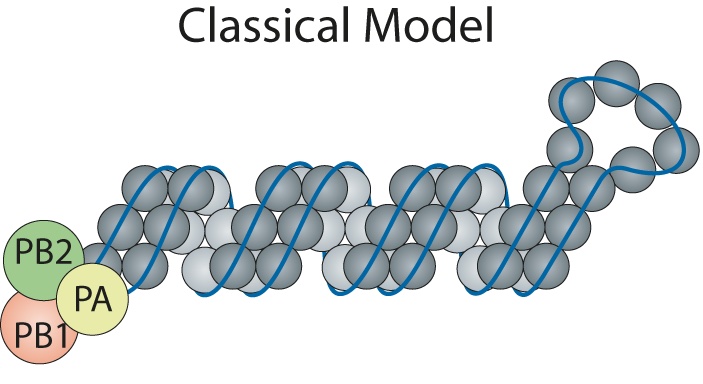Every year we go through the same motions: Scientists figure out what the most common flu strains will be, and prepare a vaccine that will best protect against it. Those who get vaccinated avoid the new strains, those who don’t might get sick. But every so often, a new kind of flu pops up that doctors are unprepared to vaccinate against. That kind of flu can turn into a pandemic.
Image: Guilherme Tavares/Flickr
Predicting what the pandemic flu strain might look like requires deep understanding of the influenza virus. This understanding goes beyond how it gets transmitted, and down to the genetic makeup of the virus itself. A collaboration between the labs of University of Pittsburgh researchers Nara Lee and Seema Lakdawala took a look at the shape of that viral genome and found an unexpected arrangement of genetic material that could require some textbook rewrites, and may help model the next pandemic strain.
The influenza A virus, in our previous understanding, had a pretty simple structure: Eight strands of genetic material (called RNA, which looks like half of a DNA strand but is a little different) wrapped snugly and uniformly around proteins. “In any textbook, the architecture will be a beautiful panhandle structure where the RNA is wrapped around these beads,” study author Seema Lakdawala told Gizmodo. “We found it’s not just beads on a string.”

Image: Lee et al, Nucleic Acids Research (2017)
The team used a method of mapping where the RNA binds with proteins called HITS-CLIP, (short for High-throughput sequencing of RNA isolated by crosslinking immunoprecipitation), to overturn that textbook picture. They found that viruses might have loops of RNA hanging out like pieces of unwound thread in a jumper.

Image: Lee et al, Nucleic Acids Research (2017)
This all might sound pretty esoteric, but it could have some important implications for studying the flu virus. Even similar strains of the flu could have different arrangements of these free loops, according to the paper published recently in the journal Nucleic Acids Research. Studying these loops might help scientists understand how the RNA arranges itself, and how viruses overcome immune attacks from their hosts. It might even help scientists to model how influenza recombines and shuffles genetic material around, creating unexpected strains that could cause pandemics.
There’s a modern day example that should make this all sound more real: 2009’s swine flu pandemic. Lakdawala started studying the flu for the National Institutes of Health in 2009, when they thought the next flu pandemic would come from a bird, not a pig. She told Gizmodo it’s possible one strain of flu virus from a European pig mixed with another strain from an American pig, and the genetic material recombined based on the influenza viruses’ structures of balls, string and loops, creating the pandemic-causing swine flu strain. “That virus was then able to transmit into a person, and that transmits person to person,” she said.
Folks now look at pigs and birds to see where the next strain might come from. “Perhaps now we’re doing a better job with surveillance in pig,” she said, “But I think we could get caught off guard with a reassortment,” a shuffling around of genetic material based on this viral genomic structure.
Form and function are intimately related when it comes to things such as viruses, protein and DNA. A simple change in scientists’ understanding of the way genetic material is arranged can have an immense impact on figuring out how it works. In the case of the flu, that understanding could possibly even save lives.
